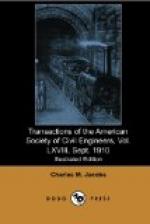[Illustration:
Fig. 6.
DETAIL OF BENTS FOR MATERIAL TRESTLE.]
The bents for the upper floors of the pier were double-decked, with 12 by 12-in. posts, sills, intermediate and top caps, and 3 by 8-in. longitudinal and cross-bracing. The bents for the incline were similar, except that those below 16 ft. in height were of single-deck construction. The spacing of the bents varied from 9 ft. 6 in. to 12 ft., except the three outer bays, which had a span of 23 ft., all to agree with the position of the pile bents. The double-deck construction extended for the full length of the original pier. A single-deck extension, of full width and 180 ft. in length, was subsequently built for the accommodation of four derricks for handling building material and large rock. The piles for this extension were driven in three sets of four rows each, similar to those in the old portion of the pier, except that the bents were driven with a uniform spacing of 15 ft. between centers. The three sets of bents were topped separately with 12 by 12-in. caps and 12 by 12-in. dock stringers; they were braced with both cross and longitudinal low-water bracing, and were tied together by a continuous 12 by 12-in. timber over the dock stringers and 12 by 12-in. packing pieces from stringer to stringer, each of these ties being supported in the center of the span over the tunnels by two 2-in. hog rods, Section “A-A,” Fig. 4.
The south side of the upper deck of the pier carried three sets of nine hoppers, each set covering 90 ft., a little less than the full length between bulkheads of the largest deck scows, with 70 ft. clear between sets, to allow for the length of a scow outside of the bulkhead and to permit the free movement of boats. Each hopper occupied the full space between two bents, and, as the caps were topped by strips of timber of triangular section, with a width of 12 in. on the base and a height of 6 in., protected by a 6 by 6-in. steel angle, each set of hoppers presented 90 lin. ft. of continuous dumping room. The bottoms of the hoppers, set at an angle of 45 deg., were formed by 12 by 12-in. timbers laid longitudinally, running continuously throughout each set, and covered by 3-in. planking. The partitions were formed with 4-in. planks securely spiked to uprights from the floor of the hoppers to the caps; these partitions narrowed toward the front and bottom so as to fit inside the chutes. Each hopper was lined on the bottom and sides with 1/2-in. steel plates, and the bottoms were subsequently armored with 2 by 1-in. square bars laid 3 in. on centers and bolted through the 12 by 12-in. flooring of the hoppers. The chutes, extending from the bottom of the hoppers, were 20 ft. long and 7 ft. wide, in the clear; they were formed entirely of steel plates, channels, and angles, and were supported from the upper deck of the pier by chains; their lower ends were 17 ft. above mean high tide and 14 ft. 6 in. from the string piece of the pier. The hoppers and chutes are shown by Fig. 1, Plate LVI.




